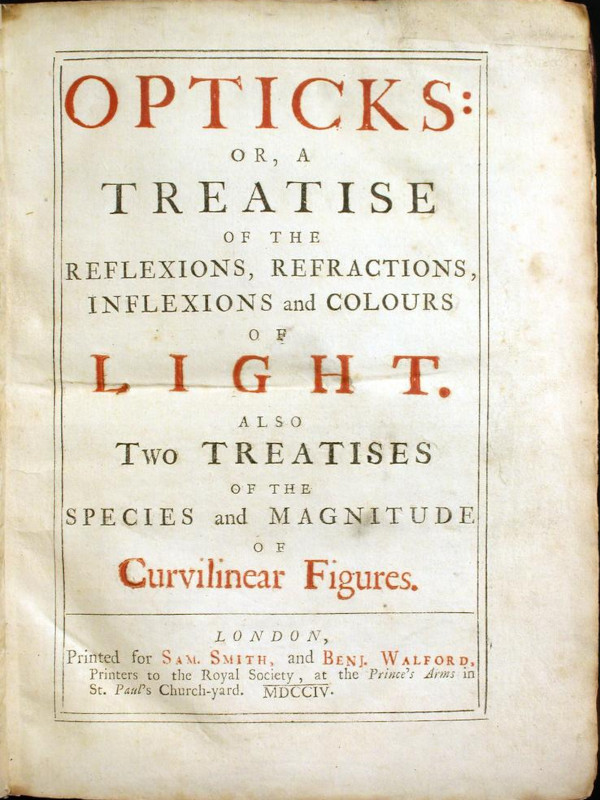Opticks (Book) AKA or, A Treatise of the Reflexions, Refractions, Inflexions and Colours of Light

Opticks
1704 AD - 1706 AD
AKA or, A Treatise of the Reflexions, Refractions, Inflexions and Colours of Light
A collection of three books by Isaac Newton published in English.
The treatise analyzes the fundamental nature of light by means of the refraction of light with prisms and lenses, the diffraction of light by closely spaced sheets of glass, and the behavior of color mixtures with spectral lights or pigment powders.
Opticks was Newton's second major work on physical science and it is considered one of the three major works on optics during the Scientific Revolution (alongside Johannes Kepler's Astronomiae Pars Optica and Christiaan Huygens' Treatise on Light).
The major significance of Newton's work is that it overturned the dogma, attributed to Aristotle or Theophrastus and accepted by scholars in Newton's time, that "pure" light (such as the light attributed to the Sun) is fundamentally white or colorless, and is altered into color by mixture with darkness caused by interactions with matter. Newton showed the opposite was true: light is composed of different spectral hues (he describes seven – red, orange, yellow, green, blue, indigo and violet), and all colors, including white, are formed by various mixtures of these hues.
He demonstrates that color arises from a physical property of light – each hue is refracted at a characteristic angle by a prism or lens – but he clearly states that color is a sensation within the mind and not an inherent property of material objects or of light itself. For example, he demonstrates that a red violet (magenta) color can be mixed by overlapping the red and violet ends of two spectra, although this color does not appear in the spectrum and therefore is not a "color of light".
By connecting the red and violet ends of the spectrum, he organized all colors as a color circle that both quantitatively predicts color mixtures and qualitatively describes the perceived similarity among hues.
It turns out that A.H. Munsell and Newton shared the concept of likening color notation to music notation. In his original color wheel (1704), Sir Isaac Newton included musical notes correlated with color beginning with red and dividing the circle by the musical scale starting with D and ending with the octave of D. → Sir Isaac Newton’s Influence on the Color Wheel
Resources
- Wikipedia, Opticks
- University of Cambridge Digital Library, Hydrostatics, Optics, Sound and Heat → This large accumulation of papers dates from about 1672-1706. It includes drafts of his book on Opticks and other miscellaneous writings.
- Munsell Color, Sir Isaac Newton’s Influence on the Color Wheel
- John Paul Caponigro, A Brief History Of The Color Wheel
- Tiago Vasconcelos. The Rivalry of Titans: Isaac Newton and Robert Hooke
- Siu A. Chin, Historia Mathematica, Modern light on ancient feud: Robert Hooke and Newton's graphical method
- The Royal Society, Newton shows the light: a commentary on Newton (1672) ‘A letter … containing his new theory about light and colours…’
- UChicago Library, Color Theory








